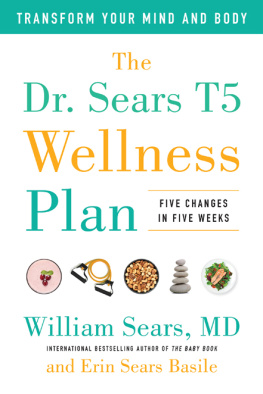Copyright 2009 by William Sears, M.D.
All rights reserved. Except as permitted under the U.S. Copyright Act of 1976, no part of this publication may be reproduced, distributed, or transmitted in any form or by any means, or stored in a database or retrieval system, without the prior written permission of the publisher.
Little, Brown and Company
Hachette Book Group
237 Park Avenue, New York, NY 10017
Visit our Web site at www.HachetteBookGroup.com
First eBook Edition: April 2009
Little, Brown and Company is a division of Hachette Book Group, Inc.
The Little, Brown name and logo are trademarks of Hachette Book Group, Inc.
ISBN: 978-0-316-05298-6
Sears Parenting Library
The Vaccine Book
The Healthiest Kid in the Neighborhood
The Baby Sleep Book
The Premature Baby Book
The Pregnancy Book
The Baby Book
The Birth Book
The Attachment Parenting Book
The Breastfeeding Book
The Fussy Baby Book
The Discipline Book
The Family Nutrition Book
The A.D.D. Book
The Successful Child
Parenting.com FAQ Books
The First Three Months
How to Get Your Baby to Sleep
Keeping Your Baby Healthy
Feeding the Picky Eater
Sears Childrens Library
Baby on the Way
What Baby Needs
Eat Healthy, Feel Great
You Can Go to the Potty
To my children:
James
Robert
Peter
Hayden
Erin
Matthew
Stephen
Lauren
and grandchildren:
Andrew
Alex
Joshua
Lea
Jonathan
Ashton
Morgan
Thomas
I have tried my best to protect you from NDD. I hope parents and grandparents the world over will do the same with their families.

To get the most out of your personal NDD-prevention plan, I suggest you take advantage of the following additional resources:
The Family Nutrition Book: Everything You Need to Know About Feeding Your ChildrenFrom Birth Through Adolescence
The Healthiest Kid in the Neighborhood: Ten Ways to Get Your Family on the Right Nutritional Track
Visit Dr. Sears online at www.AskDrSears.com to find the following:
a free subscription to our bimonthly nutritional and parenting newsletter
a downloadable traffic-light eating chart that you can put up on your refrigerator
mom-to-mom moments: helpful parenting and nutritional tips from my daughter Hayden Sears-Livesay
the food forum, an interactive blog where parents share their favorite recipes and feeding strategies, and the Drs. Sears add their comments
our personal recommendations on nutritional sup plements
updated information from each member of the Sears team: Drs. William, Robert, James, and Peter; Hayden Sears-Livesay; and Martha Sears

Children are getting sicker, sadder, and fatter. Why? The problem is food, glorious food! During my thirty-six years as a pediatrician, I have never before seen such an epidemic of nutrition-related illnesses. In this book you will learn a new name that I have given to this epidemic: NDD, which stands for nutrition deficit disorder. The cause? Children have lost their taste for real food. The treatment? Reshape their taste back to eating real food. Thats what you will learn to do in this book.
Fake food, as you will soon learn, can cause illnesses, and parentsand even many doctorshave lost sight of the fact that real food is real medicine. I will take you inside a childs brain and other body parts so that you can see how real food acts as medicine. You will learn how real food turns on the bodys own internal pharmacy and how junk food interferes with the bodys own natural internal medicines.
In part 1, you will learn why you must make changes in your familys way of eating to prevent NDD. In part 2, you will learn how. By following my seven steps for preventing NDD, you will be well on your way to giving your family the lifelong gift of health. To help you make NDD prevention part of your daily family living, in part 3 we will share our favorite meal plans and recipes.

Does Your Child Have NDD?
I n this section Ill take you on a feeding trip through a childs body. You will be amazed when you see how real foods (occurring in nature) make the brain grow smarter, and fake foods (made in a factory) lead to failing grades. You will learn about a new condition, Nutrition Deficit Disorder (NDD), figure out whether your child has it, and learn how to prevent and treat it. If you are a motivated parent who already knows the connection between good eating and good health, these early chapters will reinforce your choices. If you arent there yet, this part of the book will get you there.

The story begins on a typical day in the office of Sears Family Pediatrics, where I have the privilege of practicing medicine with my three sons. What happened that day changed the way I practice pediatrics forever and influenced the health of hundreds of my patients. That was the day this book was born.
Welcome to our office. How can I help you? I greeted my first patient.
Johnnys school thinks that he has ADD, his mother began.
Attention deficit disorder. Hmm . Tell me, what does Johnny have for breakfast? I inquired.
Hi-C and a Pop-Tart, Johnnys mother confessed.
What does he have for midmorning snack?
Usually nothing, but sometimes he has some chips.
What does he have for school lunch?
Oh, the usual pizza and stuff that kids eat.
Johnny does not have ADD, he has NDD! I said spontaneously, straight from my heart.
Ill never forget the surprised look on this mothers face. She had no idea what on earth NDD was, but it sounded like something she didnt want her child to have.

Nutrition deficit disorder, I interpreted.
I went on to explain to this puzzled parent that the brain, above all other organs, is affected, for better or worse, by what we eat. You put junk food into a childs brain, you get back junk behavior, junk learning, and junk mood. Its as simple as that! The mothers look of amazement immediately changed to one of comprehension. Oh! That makes sense. I get it! NDD. Relieved, she said, So he doesnt need drugs?
No, not the prescription kind. He just needs to eat real food, because real food is real medicine.
It was then that I realized that this mother, and many other moms like her, didnt understand that food can affect how her child learns, behaves, and feels.
DOES YOUR CHILD HAVE NDD?
Here are the main signs we look for when diagnosing a child with NDD:
 frequent mood swings
frequent mood swings
 unrelenting temper tantrums
unrelenting temper tantrums













 frequent mood swings
frequent mood swings